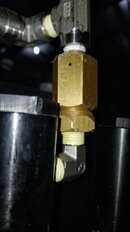- Messages
- 20,804
- Reaction score
- 15,531
- # of dives
- I'm a Fish!
sort of?
if you have a gauge after the PMV it will read whatever is in the line. What the PMV does is not allow any gas to pass until the set pressure is reached. Once it is reached, it still has to equalize.
So. If your PMV is set to 2000psi and you have a gauge right before and right after the PMV, you just changed the filter cartridges and are about to fill an AL80 that is just back from hydro and completely empty
You start the pump and the gauge before the PMV starts climbing to 2000 psi but the gauge after the PMV stays at 0.
Once the filter towers reach 2000psi, the PMV allows gas to pass and you will see 2000psi on the gauge prior to the PMV, and then the gauge after will start to increase slowly as the tank is filled.
Once the tank pressure exceeds 2000psi, both gauges will increase together.
If you have an empty filter tower, and you hook up a full tank to the fill whip and open it, it will not allow gas to go backwards through the PMV and fill the towers.
if you have a gauge after the PMV it will read whatever is in the line. What the PMV does is not allow any gas to pass until the set pressure is reached. Once it is reached, it still has to equalize.
So. If your PMV is set to 2000psi and you have a gauge right before and right after the PMV, you just changed the filter cartridges and are about to fill an AL80 that is just back from hydro and completely empty
You start the pump and the gauge before the PMV starts climbing to 2000 psi but the gauge after the PMV stays at 0.
Once the filter towers reach 2000psi, the PMV allows gas to pass and you will see 2000psi on the gauge prior to the PMV, and then the gauge after will start to increase slowly as the tank is filled.
Once the tank pressure exceeds 2000psi, both gauges will increase together.
If you have an empty filter tower, and you hook up a full tank to the fill whip and open it, it will not allow gas to go backwards through the PMV and fill the towers.




